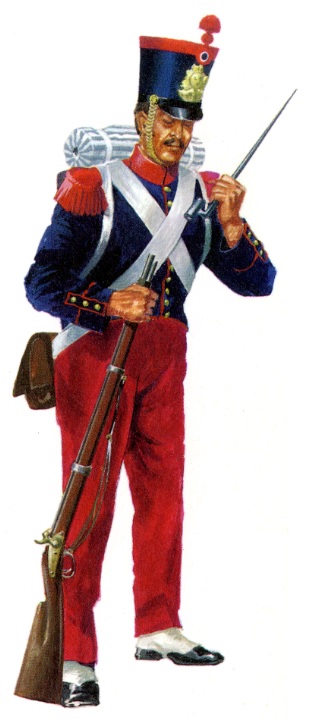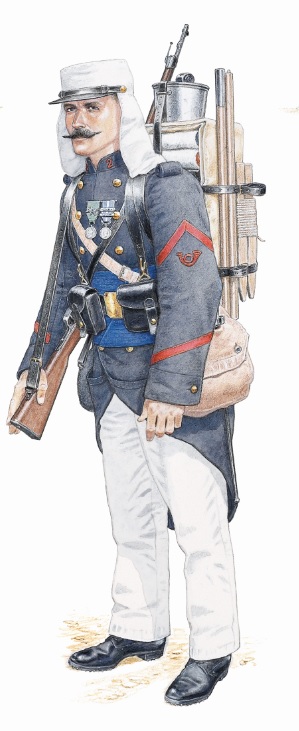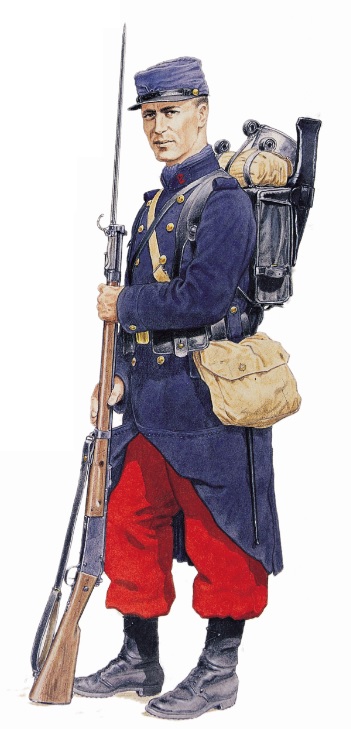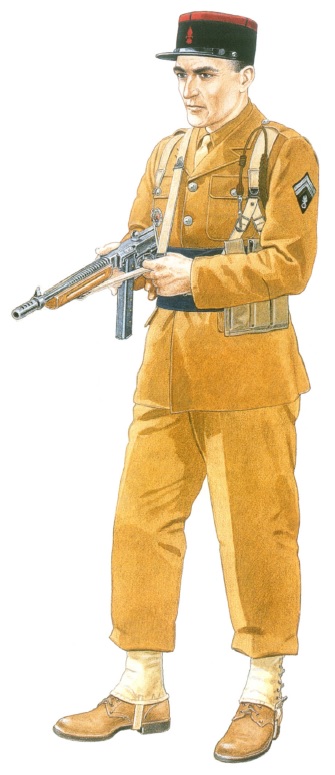On 9 March 1831 King Louis-Phillipe signed an ordinance bringing the French Foreign Legion (Légion Étrangere) into existence. Since then they have fought in wars across the globe, serving courageously in both World Wars alongside a plethora of other conflicts. To mark the 185th anniversary we will be delving into our backlist to examine the French Foreign Legion through the ages.
Artwork by Michael Roffe
Légionnaire of Grenadier Company, Algeria, 1831
Extract from Men-at-Arms 17: The French Foreign Legion by Martin Windrow
The first légionnaire. The shako is the 1825 model with red grenadier distinctions; the tricolour cockade is thought to have been introduced in 1830. It should be noted that one of hte peculiarities of the Legion was the early abandonment of the double pompoms worn by compagnies d'élite of other units - double red pompoms indicating grenadiers, double yellow indicating voltiguers. The short jacked or coatee is basically the 1822 model with red grenadier distinctions and epaullettes; the red collar was, however, common to all infantry from 1828 onward. The trousers, in garance (madder red) replaced the blue winter and white summer trousers worn up to 1829. The striped cloth case on top of the pack contained the grey 1822 model greatcoat. The musket is a flintlock; percussion arms did not appear in any numbers until the early 1840s.
Artwork by Mike Chappell
Légionnaire de 1ère classe, 2nd RE; Figuig, 1903
Extract from Men-at-Arms 461: The French Foreign Legion 1872-1914 by Martin Windrow
This classic ‘Beau Geste’ figure is from a photo taken during the brief occupation of this important border oasis after its bombardment on 8 June 1903, when Gen O’Connor deployed two battalions of 2nd Foreign. Uniform and kit are conventional – and would be identical for the units of the Landing Corps in western Morocco four years later – but there are a few points to note. This private first class wears the campaign medal for Madagascar 1895 and the 1893 Colonial Medal with two campaign clasps. The red chevron on his left upper sleeve shows that he is serving his second enlistment; officially discontinued under Army orders of 1887, these chevrons were replaced with a line of red greatcoat and tunic cuff piping (mixed red and gold for sergeants). The Livre d’Or (1976) states that the Legion abandoned them only in 1904, and some photos show both piping and chevrons in simultaneous use; in the group photo from which we take this man a sergeant clearly wears cuff piping, and three privates the old chevrons. Note that the belt order is worn here over the musette and water canteen slings – perhaps to prevent the troops from drinking except at the authorized hourly halts.
Illustration by Mike Chappell
Légionnaire de 2e classe; Bataillon C, 2e Régiment de Marche/2e Régiment Étranger; Mailly-le-Camp, October 1914
Extract from Men-at-Arms 325: French Foreign Legion 1914-45 by Martin Windrow
Volunteers were outfitted from French Metropolitan stores exactly like Line infantry, though with a red cloth grenade for the front of the M1884 képi, and the Legion’s blue sash for wear over the greatcoat on parade. In field order, with the M1912 képi cover in bleue-mécanicien (‘workman’s blue’), only the red collar numbers on the M1877 greatcoat in gris de fer bleuté identified the unit. Red M1897 trousers were worn with M1893 boots and M1913 gaiters; belt and braces supported three M1888 cartridge pouches, one central at the back, and the frogged bayonet; the M1892 haversack (etui-musette) and one-litre 1877 water bottle were worn slung – the African veterans brought their field equipment from Algeria, so had two-litre bidons. The black leather M1893 knapsack was initially stowed only with spare boots in a bag, M1852 mess-tin (angled back to allow prone firing), and one of the squad’s tools and cooking utensils. The rifle was the 8mm bolt-action M1888/93 Lebel with eight-round magazine. (From a photo of the American volunteer and later air ace Kiffin Yates Rockwell, courtesy Paul A. Rockwell.)
Artwork by Mike Chappell
Maréchal-des-logis, 1er Régiment Étranger de Cavalerie; Austria, Spring 1945
Extract from Men-at-Arms 300: French Foreign Legion Infantry and Cavalry since 1945 by Martin Windrow
Although this cavalry sergeant preparing for a march-past wears almost entirely US issue (M1939 OD wool service dress, OD wool shirt, light OD tie, M1936 web pistol belt and suspenders, SMG magazine pouches, M1938 dismounted leggings, M1943 ‘flesh-out’ service shoes), he typifies the Legion’s determination to cling to whatever ‘tribal items they could lay hands on. Képis were in short supply; he wears the midnight blue (virtually black) and red M1927/35 troops’ model, with red applique Legion grenade badge, its white cover removed to mark sous-officier status – his rank entitles him to a silver grenade badge, but this is better than nothing. In 1943 the Legion’s arm of service badge became a midnight blue diamond-shaped écusson edged with triple green piping bearing the Legion grenade in green for troops and infantry gold or cavalry silver for NCOs, worn on the left sleeve immediately below any rank chevrons. Supplies were inadequate before the late 1940s, however, and this NCO has improvised with an M1926 tunic collar écussion, with double piping at the top two edges only. He has found silver cavalry buttons for his tunic; and has quickly secured the new fourragère or lanyard (marking a regiment’s two or three citations in Army orders) worn on the left shoulder – in the colours of the Croix de Guerre 1914-18 but distinguished by an ‘olive’ above the ferrule in the colours of the C de G 1939-40. This veteran has also managed to retain the metal regimental badge dating from 1936, worn pinned to his right breast pocket; and the Legion’s traditional dark blue parade sash. It would be 1947 before the 1er REC gave up the pale khaki necktie for the green tie, first taken from Chantiers de Jeunesse stocks and worn with walking-out dress by the RMLE in 1944. Photos of this date show submachine-guns (usually the Thompson M1928A1 or M1A1) carried by NCOs only.
Thanks for joining us in our celebration of the 185th anniversary of the French Foreign Legion!





Comments
You must be logged in to comment on this post. Click here to log in.
Submit your comment